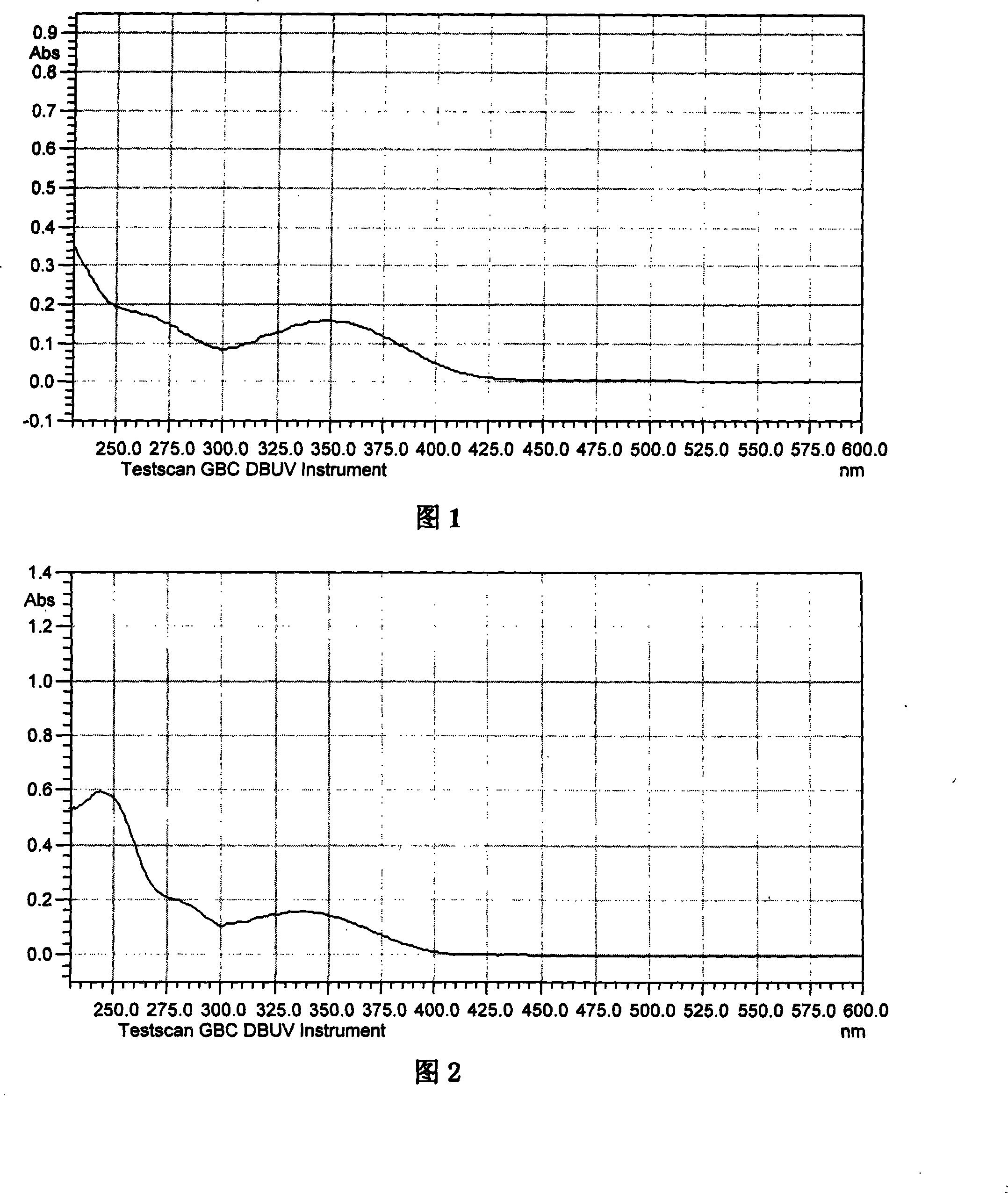Diphenyl ketone containing nitryl stilbene dye formed with ester linkage, synthesis and application thereof
A technology of nitrostilbene and benzophenone, applied in the direction of styrene-based dyes, etc., can solve the problems of short absorption wavelength and low initiation efficiency, and achieve the effect of wide absorption band, convenient source of raw materials, and convenient adjustment
- Summary
- Abstract
- Description
- Claims
- Application Information
AI Technical Summary
Problems solved by technology
Method used
Image
Examples
Embodiment 1
[0045] Synthesis of (p-nitrostilbene)-(benzophenone acid)-ester
[0046] The synthesis proceeds in three steps:
[0047] (1) Synthesis of 4-nitro-4'-hydroxy-stilbene
[0048] The ratio of 1.2g p-Hydroxybenzaldehyde and 2.26g p-nitrophenylacetic acid (molar ratio 0.8: 1) is mixed in three-necked ground flasks, add condensing device, then add 0.72g hexahydropyridine (molar ratio 1: 1.25), reacted under heating at 110°C for 6 hours, dissolved in ethanol for recrystallization, and filtered to obtain crystals with a yield of 68%, and set aside;
[0049] (2) Synthesis of 2-acyl chloride benzophenones
[0050] 1.86g of 2-carboxybenzophenone and 11.8g of SOCl 2 (molar ratio 1:10) were mixed in a three-necked ground flask, stirred for 5 hours under heating, and unreacted SOCl was removed under reduced pressure. 2 , the viscous product was obtained without further purification, the yield was 95%, and it was used for subsequent use;
[0051] (3) Synthesis of (p-nitrostilbene)-(benzoph...
Embodiment 2
[0054] The synthesis of (4-nitro-3'-methyl-4'-hydroxyl toluene)-(benzophenone acid)-ester is carried out in three steps:
[0055] (1) Synthesis of 4-nitro-3'-methyl 4'-hydroxy-stilbene
[0056] The ratio of 1.36g 3-methyl-4 p-hydroxybenzaldehyde and 2.26g p-nitrophenylacetic acid (molar ratio 0.8: 1) is mixed in a three-necked ground flask, and a condensing device is added, and then 0.72g of hexahydro Pyridine (molar ratio 1:1.25), reacted under heating at 120°C for 6 hours, dissolved in ethanol for recrystallization, filtered to obtain crystals, yield 68%, and set aside;
[0057] (2) Synthesis of 2-acyl chloride benzophenones
[0058] Synthesis is carried out by the second step in the implementation case 1;
[0059] (3) Synthesis of (4-nitro-3'-methyl-4'-hydroxystilbene)-(benzophenone acid)-ester The step (1) 2.55g 4-nitro-3'- Methyl 4'-hydroxyl-stilbene is mixed with 2.44g 2-acyl chloride benzophenone (molar ratio 1:1) prepared in (2) and added to a three-necked ground-ne...
Embodiment 3
[0061] Synthesis of (4-nitro-3',4'-dihydroxystilbene)-bis(benzophenone acid)-ester
[0062] The synthesis proceeds in three steps:
[0063] (1) Synthesis of 4-nitro-3',4'-dihydroxy-stilbene
[0064] The ratio of 1.38g 3,4-dihydroxybenzaldehyde and 2.26g p-nitrophenylacetic acid (0.8: 1 in molar ratio) is mixed in three-necked grinding flasks, add condensing device, then add 0.72g hexahydropyridine ( Molar ratio 1:1.25), reacted under heating at 130°C for 6 hours, dissolved in ethanol for recrystallization, filtered to obtain crystals, yield 68%, and set aside;
[0065] (2) Synthesis of 2-acyl chloride benzophenones
[0066] Synthesis is carried out by the second step in the implementation case 1;
[0067] (3) Synthesis of (4-nitro-3', 4'-dihydroxystilbene)-bis(benzophenone acid)-ester
[0068] Step (1) 2.57g 4-i nitro-3', 4'-dihydroxy stilbene and 6.1g 2-acyl chloride benzophenone (molar ratio 1: 2.5) obtained from (2) are mixed and added to the third port ground-necked f...
PUM
 Login to View More
Login to View More Abstract
Description
Claims
Application Information
 Login to View More
Login to View More - R&D Engineer
- R&D Manager
- IP Professional
- Industry Leading Data Capabilities
- Powerful AI technology
- Patent DNA Extraction
Browse by: Latest US Patents, China's latest patents, Technical Efficacy Thesaurus, Application Domain, Technology Topic, Popular Technical Reports.
© 2024 PatSnap. All rights reserved.Legal|Privacy policy|Modern Slavery Act Transparency Statement|Sitemap|About US| Contact US: help@patsnap.com










